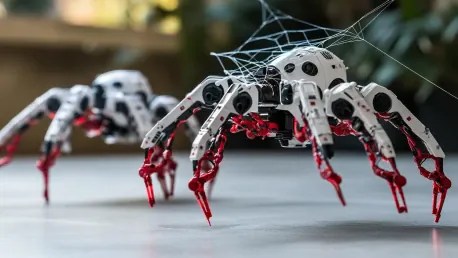Robotics technology at the Institute of Technology at the University of Tartu has taken a leap forward with a concept inspired by the web-spinning abilities of spiders. Researchers have developed robots that can spin their own physical structures from a polymer solution, offering a new level of adaptability and responsiveness in diverse environments. This groundbreaking approach involves the construction of temporary embodiments and movement pathways from a polymer solution, forming necessary components based on current environmental demands. The innovation allows these robots to dynamically create forms needed for specific tasks, making them invaluable in complex and unpredictable settings, such as disaster zones.
Innovation in Robotic Design
The cornerstone of this groundbreaking technology lies in its deviation from traditional robotics. Unlike robots with fixed and predefined bodies, these new machines can create their temporary physical forms on demand, ensuring a customized response to the specific tasks and environments they encounter. This remarkable deviation from conventional designs marks a pivotal shift in how robots are conceptualized, allowing for unprecedented flexibility and functionality.
In essence, this technology allows robots to dynamically form the components they need for specific tasks, adapting quickly to immediate situational demands. This significantly enhances their utility and effectiveness in various practical applications, ranging from intricate mechanical tasks to large-scale operations in diverse terrains. The ability to generate structure and movement pathways spontaneously sets these robots apart, placing them at the forefront of next-generation technological advancements in the realm of robotics.
In Situ Web Spinning Mechanism
Inspired by the natural silk weaving abilities of spiders, the robots spin webs from a polymer solution to create temporary structures. These webs function as limbs, movement pathways, and grippers, providing the robots with the necessary tools to interact with and navigate through complex terrains. This technique brings a unique advantage, enabling the robots to spin webs adaptable for crossing obstacles or traversing delicate surfaces. The flexibility of these polymer webs ensures that the robots can adjust their structures according to the challenges presented by their environments.
The spiders’ silk mechanism has been studied extensively to replicate its properties in synthetic analogs. The polymer solution used by the robots has been engineered to exhibit similar robustness and adaptability. This capability of in situ construction offers a range of possibilities, making these robots particularly suitable for unpredictable and changing environments. Through this innovative technique, webs are spun to safely and effectively bridge gaps, climb over obstacles, or even interact with delicate objects, underscoring the versatility and potential of this new approach to robotic design.
Ad Hoc Adaptability and Demonstrations
Demonstrations have shown that these robots can adapt to varying environments efficiently. Whether they are spinning pathways over sharp glass shards or building delicate structures to interact with fragile objects such as bird feathers, their performance underlines their incredible dexterity and resilience. These experiments highlight the practical application and real-world potential of silk-inspired web-spinning robots in tasks that demand a high degree of flexibility and situational responsiveness.
One notable experiment involved the robot spinning a fibrous limb to gently pick up a delicate flower, proving that this technology can achieve precision unattainable through predesigned embodiments. The success in handling intricate tasks indicates that these robots possess a level of finesse previously considered unachievable by traditional robots. Additionally, their performance in constructing pathways that can hold their weight and enable movement through challenging terrain emphasizes the applicability of this technology in a wide array of scenarios, demonstrating the profound impact of these innovations.
Applications in Disaster Zones
The adaptability and innovative design of these robots make them especially valuable in disaster relief operations. Their ability to dynamically form required structures and navigate unpredictable terrains positions them as essential tools for search-and-rescue missions. In disaster scenarios, these robots can create pathways and manipulate objects in real-time, significantly improving the efficiency and effectiveness of rescue operations, potentially saving numerous lives.
When deployed in disaster zones, these robots can navigate through debris, reach survivors, and even deliver necessary supplies by forming structures tailored to the immediate environment. The ability to dynamically adjust to the surroundings and perform under varying conditions is vital for disaster relief, where circumstances can change rapidly. This feature not only enhances operational capabilities but also minimizes risks to human rescuers by allowing robots to reach places that might be too dangerous for humans. The technology suggests a significant leap forward in emergency management strategies, promising a robust and reliable means of rendering aid in crisis situations.
Material Science and Design Thinking
The success of this technology results from an interdisciplinary collaboration between material science and design thinking. Researchers Marie Vihmar and Indrek Must contributed their expertise to blend practical applicability with the robustness needed for the robotic web-spinning mechanism. This harmonious integration of disciplines has resulted in a technology that not only promises high adaptability but also ensures a reliable and practical solution for real-world challenges.
Material scientists have worked meticulously to develop the polymer solution that mimics the properties of natural spider silk, focusing on tensile strength, elasticity, and durability. Design thinkers, on the other hand, have worked on operational frameworks and usability, ensuring that the end product is both functional and accessible. This collaboration underscores the importance of bringing together diverse fields of expertise to create groundbreaking technological solutions. The practical outcome is a robotic system that can address a multitude of scenarios, from industrial applications to emergency response, paving the way for future innovations based on similar interdisciplinary approaches.
Overarching Trends in Robotics
The article highlights a broader trend in robotics towards integrating natural principles and fostering adaptability in changing environments. While current language models demonstrate situational flexibility, their physical counterparts remain rigid. This new approach pushes past such limitations by enabling robots to build adaptive forms tailored to their immediate needs.
This trend aligns with bio-inspired design philosophies, aiming to create machines that can transform themselves according to environmental requirements, much like living organisms do. By observing and incorporating natural strategies, researchers are developing robots that not only mirror but also enhance the adaptive capabilities seen in nature. The integration of these principles into robotic design marks a significant progression toward creating machines that are not only highly functional but also intuitively responsive to real-world conditions.
Elimination of Fixed Structures
By eliminating the need for fixed, pre-designed structures, these web-spinning robots represent a significant shift in robotics. They suggest a future where machines can not only adapt to their environments but also actively modify them for optimal performance. This adaptability opens new possibilities in how robots can be utilized across various domains.
Ultimately, this move towards dynamic and responsive embodiment is a transformative leap in robotic design and functionality. The departure from rigid structures to self-assembling, adaptable forms redefines the potential uses and capabilities of robots, particularly in situations where versatility and immediate responsiveness are crucial. This advance sets a new standard in robotic development, paving the way for the next generation of intelligent machines capable of addressing complex tasks with nuanced precision and adaptability.
Implementation and Future Outlook
Robotics technology at the University of Tartu’s Institute of Technology has made significant strides with a concept inspired by spiders’ web-spinning abilities. Researchers have created robots capable of spinning their own physical structures from a polymer solution, introducing a new level of adaptability and responsiveness in various environments. This innovative method involves constructing temporary embodiments and pathways for movement from a polymer solution, tailoring the components to meet current environmental demands. This cutting-edge approach enables the robots to dynamically form structures necessary for specific tasks, rendering them invaluable in complex and unpredictable settings, such as disaster zones. By mimicking the remarkable web-spinning skills of spiders, the robots can quickly respond to emergencies and navigate through debris-filled environments. This advance opens up numerous possibilities for deploying robots in search and rescue missions, environmental monitoring, and other areas where flexibility and rapid adaptability are crucial for successful outcomes.









